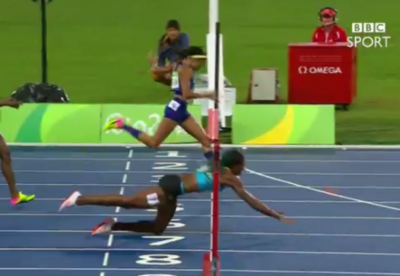Putting everything on the line
23 Aug 2016

During the olympics I heard about a couple of competitors in racing events who “dived” (or “dove”, if you’re American) across the line. The rules are clear (section 2 rule 164 IAAF rulebook):
“The athletes shall be placed in the order in which any part of their bodies (i.e. torso, as distinguished from the head, neck, arms, legs, hands or feet) reaches the vertical plane of the nearer edge of the finish line”
Whether or not it’s “sporting”, I admire sportspeople who find surprising and step-change innovative ways to win, while remaining within the rules. The athletic equivalent of cycling’s “bike throw” (the “body throw”?) won a 400m gold medal and secured a final place in hurdling in Rio.
I love hearing about situations where the nice clean rules of engagement lead to crazy competition, and the rules have to adapt - or other competitors have to adapt - to keep up. For instance, I wonder whether we’ll see future Tour de France competitors descend like Chris Froome did on this year’s Peyresourde. As it happens I think Froome’s tactics were equally worthy of admiration - attacking immediately after topping a climb. In the broader cycling world, the rulemakers can dictate how long your socks are (“Socks (and shoe covers) used in competition must not exceed the mid-distance between the ankle and the knee”); how big your bike is allowed to be; even what counts as a bike. I don’t think they will be able to specify what counts as cycling… Rule makers in all sorts of competitions have to come up with more and more detailed and lengthy lists defining what is allowed and what isn’t. I like this encroachment of the bizarre into the regimented. Examine, by way of example, the definitions of chipmunking and “picnic style” in competitive eating.
Sometimes innovation is so effective that all competitors end up adopting a new technique for all future events (viz. Fosbury Flop). Other times it’s outlawed. Somersaulting in the long jump and swimming underwater instead of backstroke would both improve distance/speed but are banned.
My favourite example of subverting the system but staying within the rules is a pretty well-known football match which finished (normal time) with one team defending both goals and the other one trying to score in either. How it happened is best left to wikipedia. Barbados 4 - 2 Grenada
Tags: sport
< Previous post | Next post >Favourite posts
- On wiggly lines and being normal
- On infinite villages
- Running a race backwards
- Brainmaking
- Their tables were stored full, to glad the sight
- The structure of a smell
Recent posts
- Start your holidays with a meta-alarm
- PGN files from handwritten chess notation
- Souvenirs des villes européennes
- Pic'n'mix reinvented
- Super slow-mo Tetris
Blog archives
Posts from 2012, 2013, 2014, 2015, 2016, 2017, 2018, 2019, 2020, 2021, 2022, 2023, 2024.